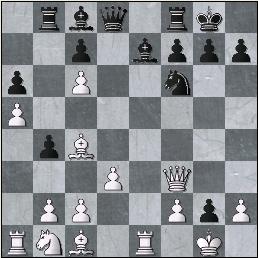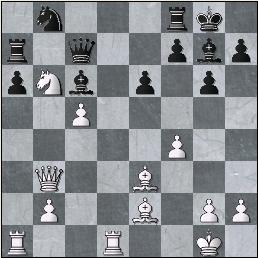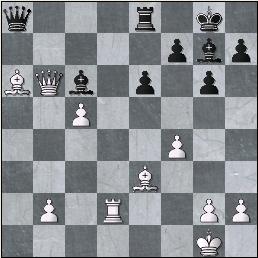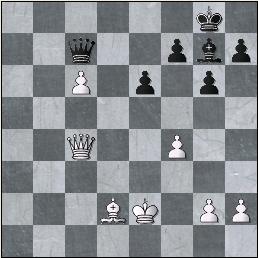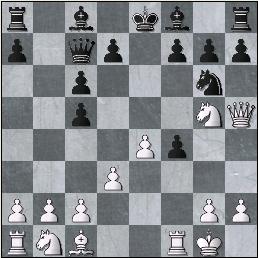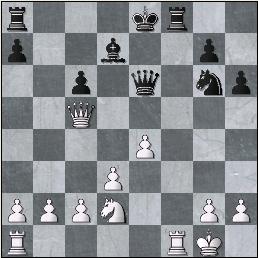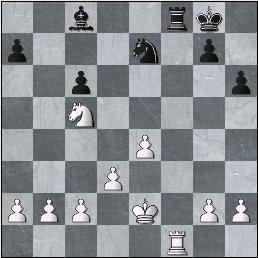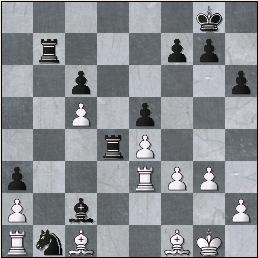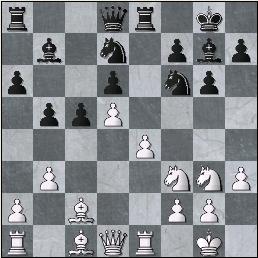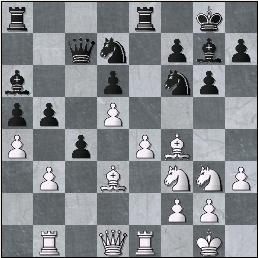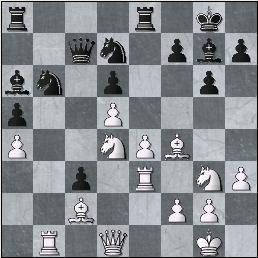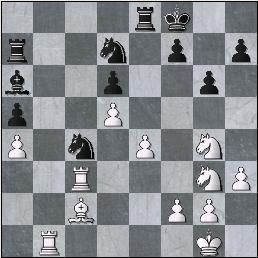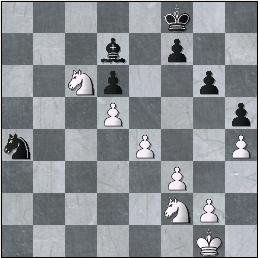15.11.2006
TAL MEMORIAL. GAMES OF ROUND 7 COMMENTED
Round 7 is remarkable in terms of opening. No hackneyed openings were seen, no Najdorf, Sveshnikov, Petroff or even Slav defence.
The ever-boring anti-Marschall was revised and truly refreshed in Ponomariov-Aronian
Ponomariov,R (2703) - Aronian,L (2741) [C88]
Tal Memorial Moscow RUS (7), 14.11.2006
1.e4 e5 2.¤f3 ¤c6 3.Ґb5 a6 4.Ґa4 ¤f6 5.0-0 Ґe7 6.¦e1 b5 7.Ґb3 0-0 8.a4 b4 9.a5 d5 Aronian chooses a rare variation with a pawn sacrifice, but fails to take Ponomariov by surprise.
10.exd5 e4 11.dxc6 exf3 12.d3 This variation should of course be compared with a Marschal attack variation with 9...e4 (i.e.8.c3 d5 9.exd5 e4 10.dxc6 exf3) that is considered dubious by theory 11.d4 is supposed to be the best reply. In our case just like in the mentioned Marschall branch taking on f3 is dangerous for white, after 12.Јxf3 Ґg4 13.Јd3 Јxd3 14.cxd3 Ґc5 15.Ґc4 ¦fe8 white found himself in a miserable position, Baramidze-Graf, GER-ch 2005; after 12.d4 fxg2 there's no Јd1-f3 that is the best move in analogous position of the line mentioned, and 13.Ґg5 ¤d5 14.Ґxe7 ¤xe7 15.d5 ¤g6 led to an unclear position in Suetin-Zaitsev, USS¦ 1983
12...fxg2 13.Јf3 ¦b8 14.Ґc4 More subtleties caused by a2-a4, b5-b4 and a4-a5 inclusion are revealed: black tried to transfer the rook to the kingside by ¦b8-b5, white prevents the manoevre.
14...¤e8 The novelty. Black managed to insist upon ¦b8-b5 after 14...Ґe6 15.¤d2 Ґd5 16.Ґxd5 ¤xd5 17.¤c4 Ґf6 18.Ґd2 ¦b5 in Borris-Graf,Bundesliga 2005
15.Ґf4 Ґf6 ¤e8-d6 turned out to be one of those notorious threats that are always stronger than their carrying out. After15...¤d6 16.¤d2 ¤xc4 17.¤xc4 Ґe6 18.Ґe5! advantage is one the white's side, while now white has to sacrifice a pawn.
16.¤d2 Ґxb2 17.¦ab1 Ґc3 18.Ґg5 Ponomariov said after the game he could not resist the temptation of the spectacular move, while 18.Јg3 may have been stronger; 18.¤e4?! Ґxe1 19.Ґg5 fairly evaluated by Maxim Notkin as rowdy after 19...Јd4 20.Ґe7 ¤d6 21.¤xd6 Ґg4 drives white to a choice between a worse position after 22.Јxg2 cxd6 23.Ґxf8 ¦e8 24.Ґxd6 Јxd6 25.Јxg4 Јxc6 and a bad one after 22.Ґxf7+ ўh8 23.Јxg2 b3!
18...Ґf6 19.¦xe8 ¦xe8 20.¤e4
This picturesque position is actually dead drawn, a series of forced moves makes the conclusion obvious. 20...¦xe4 20...Ґxg5 21.¤xg5 would be lethal for black.
21.Ґxf6 Јxf6 22.Јxf6 gxf6 23.dxe4 ўf8 24.ўxg2 Ponomariov mentions impossibility of 24.c3 bxc3 25.¦xb8 c2 for white 24...ўe7 25.¦d1 Maxim Notkin showed how the opponents would have to fill the pipe of piece in such a position in Sofia:25.¦d1 Ґe6 26.Ґxe6 (26.Ґxa6 ¦a8 27.Ґd3 ¦xa5 28.¦b1 ўd6) 26...ўxe6 27.¦d7 ¦b5 28.¦xc7 ¦xa5= etc. 1/2-1/2
Gelfand,B (2733) - Svidler,P (2750) [A05]
Tal Memorial Moscow RUS (7), 14.11.2006
1.¤f3 1...¤f6 2.c4 g6 3.¤c3 d5 4.Јa4+ Ґd7 5.Јb3 dxc4 6.Јxc4 a6 7.d4 b5 8.Јb3 c5 9.dxc5 Ґg7 10.e4 0-0 11.Ґe2 Ґc6 Peter with black chose an unpopular path in Anti-Gruenfeld and this position is already a new one. Yet it differs from a well-known one from 5.Јb3 system in Gruenfeld defence just with the black light-squared bishop position (cf. 1.d4 ¤f6 2.c4 g6 3.¤c3 d5 4.¤f3 Ґg7 5.Јb3 dxc4 6.Јxc4 0-0 7.e4 a6 8.Ґe2 b5 9.Јb3 c5 10.dxc5 Ґb7) Mainline in that system is 11.0-0 and the game we consider could transpose to that line after 12.0-0 ¤xe4 13.¤xe4 Ґxe4
To understand a subtlety of Gelfand's reaction let's consider a couple of games from that Gruenfeld line (the position is the diagram one, just with black bishop on b7 instead of c6): 11.e5!? (less popular than11.0-0) 11...¤fd7 12.Ґe3 and now black tried immediate 12...¤xe5 13.¤xe5 Ґxe5 14.0-0 ¤c6! That's what important for us! 15.¦ad1 ¤d4 and black had no problems in Arakelov-Vorobiov, Vladimir 2004I have a feeling that after 13.¦d1 Јc7 14.¤d5 Ґxd5 15.Јxd5 ¤bc6 white was better in Gavrikov-Pfrommer, Wuerzburg 1991, but black managed to escape very soon. An alternative is 12...e6 13.0-0 Јc7! I am not a specialist in the variation to judge whether this opportunity promises black any happy life, moreover white reached some advantage after 14.a4 ¤xc5 15.Јb4 ¤xa4 16.¤xa4 bxa4 17.Јxa4 ¤c6 18.¦fc1 in Farago-Ftacnik, Ljubljana 1998, yet the idea should be mentioned. From this games we can see that the bishop is misplaced on c6 and of course Boris Gelfand known as one of the first universal chess encyclopaedia written on a biological carrier demonstrate an impressively profound understanding of the position by an instant grasping this small but crucial difference.
12.e5! ¤fd7 13.Ґe3 ¤xe5 14.¤xe5 Ґxe5 15.0-0 e6 Black could try to save time on this move:15...Јc7 16.f4 Ґg7 17.a4 (after17.¤d5 Ґxd5 18.Јxd5 ¤c6 black threatens both to put the knight on d4 after ¦d8 and to take on b2 and is therefore not so bad. ) 17...bxa4 18.¤xa4 ¤d7 19.¤b6 Јb7 but I do not see what it could principally change, white can choose between exchanging the light-squared bishops by 20.Ґf3 or refraining from it by 20.¦f2 A clear advantage is on his side.
16.a4 bxa4 17.¤xa4 Јc7 I suppose that sofar the semi-technical position after 17...¤d7 18.¤b6 ¤xb6 19.cxb6 (19.Јxb6 Јd7 gives black more hopes) can hardly be convicted as lost for black, it therefore can be hold. But I hesitate to call it an improvement. I have to say that in my brief analysis I fail to find any sensible solution for black after the 12th move. Is there any?
18.f4 Ґg7 19.¤b6 ¦a7 20.¦fd1
20...¦e8 21.Ґc4 Ґh6 22.¦f1 Јb7 23.¦f2 ¤d7 24.¤xd7 Јxd7 25.¦xa6 ¦xa6 26.Ґxa6 Ґg7 27.¦d2 Јa7 28.Јb6 Јa8
Black sacrificed a pawn and seemingly achieved some prospects for piece activity, but at this moment Gelfand finds a perfect means to discourage any hopes. He gives his extra pawn back and allows black just to watch his c-pawn gradually proceeding to its promotion point.
29.Ґb5! White could easily spoil everything by a couple of careless moves like: 29.b4 ¦b8 30.Јc7 Ґf6 31.¦d6 Ґe8 32.¦b6?! ¦xb6 33.Јxb6 Јe4
29...Ґxb5 30.Јxb5 ¦b8 31.Јc4! 31.Јd7 Јe4 is less precise, white takes everything under control 31...Јa1+ 32.ўf2 ¦xb2 33.c6 ¦xd2+ 34.Ґxd2 Јa7+ 35.ўe2 Јc7
36.Ґa5 Јc8 37.c7 Ґf8 38.Јc6 f5 39.Ґc3 ўf7 40.Ґe5 Ґe7 41.ўd3 g5 42.g3 gxf4 43.gxf4 1-0
Brilliant achievement by Gelfand. I am inclined to take this game as an opening catastrophe and therefore I'd wish to Peter not to get too much frustrated and show his best in the remaining rounds.
Grischuk seems to have caught the right thread of play. Well, converse would be somewhat strange – he discovers new opening ideas in every game!
Grischuk,A (2710) - Shirov,A (2720) [B30]
Tal Memorial Moscow RUS (7), 14.11.2006
1.e4 c5 2.¤f3 ¤c6 3.Ґb5 e6 4.Ґxc6 bxc6 5.d3 ¤e7 6.Јe2 Јc7 Does this Shirov'simplies black's having problems after 6...¤g6 7.h4? 7.¤g5 e5 7...¤g6 8.f4 c4 is the latest fashion introduced by ¦adjabov. 8.f4 exf4 9.0-0 ¤g6 10.Јh5
10...d6 Black experienced problems in this line after 10...Ґd6 11.g3 Ґa6 12.gxf4 ¦f8 13.e5 Ґe7 14.¤c3 (Bologan-Lautier Hrokurinn rapid 2004) Shirov's provoking the knight sacrifice should not be approved either, black's defence is far from easy, white taking no risk at all.
11.Ґxf4 h6 12.¤xf7! Јxf7 13.Ґxd6 Јe6 14.Ґxf8 14.Јxc5? Ґxd6 15.Јxc6+ Јd7 16.Јxa8 ¤f4-/+ 14...¦xf8 15.¤d2 Ґd7 16.Јxc5
16...Јe7 To have a king in the center is dangerous, but the endgame is rather gloomy for black. We are all brave in the analysis, maybe black can take a risk with 16...¤f4 17.¤c4 Јg4 trying to get an improved version f the endgame after, say, 18.¤e3 Јg5...
17.¦xf8+ ўxf8 18.¦f1+ ўg8 19.Јxe7 ¤xe7 20.¤b3 ¦d8 21.¤c5 Ґc8 22.ўf2 ¦f8+ 23.ўe2
23...¦xf1 Black could try 23...Ґg4+ 24.ўe1 ¤g6 bothering white with the idea of putting his bishop from behind white's pawns. But I think black would have more hopes on blockading white pawns after 23...¦f6! 24.ўxf1 ¤g6 25.b4 ўf7 26.ўe2 ¤f4+ 27.ўf3 ¤e6
28.¤b3! An important moment. White pawns haven't yet advanced enough to afford him exchange knights. After28.¤xe6 ўxe6 29.ўe3 ўd6 30.c4 c5 31.a3 Ґd7 (I am curious if black can save after31...Ґe6?! 32.ўd2 Ґf7 33.bxc5+ ўxc5 34.ўc3 Ґg6 35.d4+ ўd6 36.ўd3 Ґh7, but the more precise move in the text spares me from the necessity to satisfy this curiosity.) 32.ўd2 ўe5! 33.ўe3 ўd6 black even manages to prevent bxc5 and d3-d4.
28...ўe7 29.ўe3 ўd6 I think it was a high tie for black to think of his counterplay 29...g5 30.d4 h5 starting from this point I do not see how black could do better.
30.d4 ¤c7 31.c4 Ґe6 32.ўd3 [Of course 32.d5?? cxd5 33.exd5 Ґxd5=] 32...Ґg8 33.a4 ¤e6 34.g3 ¤g5 35.¤d2 a6 36.h4 ¤h3 37.ўe3
Black desperate attempt only left him devoid of the knight. The position is obviously hopeless. 37...g5 38.d5 cxd5 39.exd5 gxh4 40.gxh4 Ґh7 41.¤e4+ ўe5 42.¤c5 ¤f4 43.d6 ¤e6 44.d7 ¤d8 45.¤xa6 ўd6 46.¤c5 Ґg8 47.ўd4 ¤c6+ 48.ўc3 ўe7 49.b5 ¤e5 50.b6 ¤xd7 51.b7 1-0
Grischuk started his mighty finish right after I wished him royal-flush. Should I change my work? Should I buy a crystal ball or what? "Gimme a dime mistah, gonna tell ya all your fate mistah, gonna be rich and happy..."
Carlsen,M (2698) - Leko,P (2741) [E20]
Tal Memorial Moscow RUS (7), 14.11.2006
Young talent's optimism made him deviate from moves repetition right after the opening and drove him eventually to a position on the diagram below.
Black is using a not so often to be seen idea of cutting off one of the rooks on the first rank. White is half-stalemated. And yet black cannot reach anything tangible. You may laugh, but probably the latent power of bishops currently tamed should be kept in mind even in such situations.
35...¦d8 Kasparov mentioned 35...¦xf3 36.Ґxf3 ¤xf3+ 37.ўf2 Ґxe4 as leading to black's advantage, and if trace the game back from the end it will seem the only way to change the course of the events. Yet after 38.h3 f5 39.¦d1 white has good chances to activate his pieces. Moreover, we can understand Leko who saved against Grischuk a similar position where Grischuk's advantage was much bigger than Leko's would have been if he had chosen this line...
36.¦e1 Ґc2 37.Ґc1 ¤b1 38.c4 ¦d4 39.c5 a4 40.Ґf1 a3 41.¦e3
Black redeployed his pieces, white's position is still totally discoordinated... And still the evaluation holds, nothing tangible.
41...¦a7 Dvoretsky's suggestion 41...¦d1 42.Ґxa3 Ґa4 looks beautiful indeed. Unfortunately white can move the only piece that actually moves in this position: 43.ўf2 ¦d2+ (43...¦bd7 44.Ґb4) 44.ўg1 draws.
42.¦e2 Ґd3 Ґy 42...¦c4 black can try to provoke white to 43.¦xc2?? ¦xc2 44.¦xb1 ¦xa2-+, but cannot succeed: after 43.Ґe3¦b7 44.¦e1 ¦c3 45.ўf2 black reaches nothing.
43.¦e3 Ґxf1 44.¦xb1 ¦d1 45.ўf2 Ґd3 46.¦b8+ ўh7 47.¦e1 ¦xe1 48.ўxe1 Ґc4 49.¦d8! ¦a5 [49...Ґxa2 50.¦d3] 50.¦d2 f6 51.¦c2 Ґe6 52.ўd2 g5 53.¦c3 ўg6 54.¦xa3 ¦xa3 55.Ґxa3 Ґxa2 1/2-1/2
I must say it was a rather unusual and unexpected illustration to the fact that stalemate leads to draw.
Morozevich has all the chess grounds to be frustrated by his game, but from our point of view on Morozevich's play in this tournament – and we used to consider it in terms of fate – 6 draws in a row his opponent made is a trend even Moro cannot break.
Morozevich,A (2747) - Mamedyarov,S (2728) [C95]
Tal Memorial Moscow RUS (7), 14.11.2006
1.e4 e5 2.¤f3 ¤c6 3.Ґb5 a6 4.Ґa4 ¤f6 5.0-0 Ґe7 6.¦e1 b5 7.Ґb3 d6 8.c3 0-0 9.h3 ¤b8 10.d4 ¤bd7 11.¤bd2 Ґb7 12.Ґc2 ¦e8 13.¤f1 Ґf8 14.¤g3 g6 15.b3 exd4 Traditional way of playing here is 15...Ґg7 16.d5 ¤b6 17.¦b1; to persist on 15...d5 would be too optimistic. Mamedyarov strives to deviation from known paths. 16.cxd4 c5 17.d5 Ґg7
This type of position is unpleasant for black.18.¦b1 It's interesting that in the only game played in this position white eventually reached success with a blunder18.Ґf4? Kasimdzhanov-Stevic, Jahorina BIH-chT 2003 18...¤xd5 19.exd5 ¦xe1+ 20.Јxe1 Јf6 could unpleasantly surprise the ex-world-champion.
18...a5 19.Ґf4 Јc7 [19...¤b6 20.Ґd3 Ґa6 21.a4 b4 22.Ґxa6 ¦xa6] 20.Ґd3 Ґa6 21.a4 c4
22.bxc4 Black must have hoped to complicate the matter after22.axb5 cxd3 23.bxa6 ¤c5, white doesn't need it. 22...bxc4 Other traditional for this structure reactions give white clear advantage: 22...bxa4 23.Ґf1; 22...b4 23.¦c1
23.Ґc2 c3 The pawn falls here. After 23...¤c5 black must have disliked 24.e5 dxe5 25.d6 (25.¤xe5 Јd8 is maximum the same) 25...Јd8 26.¤xe5 and white's activity is unpleasant; a clearly antipositional idea may have deserved attention: 23...¤e5!? 24.¤xe5 dxe5 25.Ґe3 ¤d7 and knight goes to d3
24.¦e3 24.Ґe3 ¦ab8 is much less efficient
24...¤b6 25.¤d4 ¤fd7
26.¤df5 The move that suggests itself. 26.¤ge2 ¤c4 27.¦xc3 ¤c5 is much less spectacular and much less effective. Putting the other knight couldbe at least not worse, d4-knikght could be put to c6 at some moment: 26.¤gf5 Ґe5 27.¤h6+ ўg7 (27...ўf8 28.¦f3) 28.Ґxe5+ ¤xe5 (28...dxe5 29.¤df5+ ўf8 (29...gxf5 30.Јh5) 30.Јf3 f6 31.¦xc3+-) 29.¤g4 and c3-pawn falls anyway. Yet the text move s quite enough and wins c3 pawn by a clearer means.
26...Ґe5 Black cannot accept the sacrifice. We skip the variations. 27.¤h6+ ўf8 28.Ґxe5 ¤xe5 29.Јd4 ¤bc4 30.¦xc3 Јa7 31.Јxa7 ¦xa7 32.¤g4 ¤d7
White's position is winning, yet fine technique is required to prove it. 33.f3 h5 34.¤f2 ¦c8 35.¤e2 [35.Ґd3] 35...¤a3 36.¦xc8+ Ґxc8 37.¦c1 ¦c7 38.Ґd1 ¦xc1 39.¤xc1 ¤b1 40.¤b3 ¤c3 41.¤xa5 ¤b6 42.h4 Ґd7 43.¤c6 ¤bxa4 44.Ґxa4 ¤xa4
The diagrams comparison shows that Morozevich dropped a part of his advantage. Yet the postion must still be winning. We skip the ending of the game, as ananlysis of such an endgame would require a separate column. I'd just mention that Morozevich' carrying out e4-e5 appears to be premature, it seems white should have tried first to use his two-knights advantage.
...... Draw on move 103.
1/2-1/2
Mamedyarov is partially right that it's not his fault that all his games are drawn. Yet his stubborn and creative defence of difficult positions is remarkable. And only Shakhriyar himself knows why he can't reach any position with good winning prospects at least once in this tournament.

